Der obige Vortrag mit dem Titel „Radical Re-Inventing Our Daily Work – Interactive Agency went Google“ ist ein erster Erfahrungsbericht der Einführung von Google Apps Premier Edition bei SinnerSchrader.
Holger Blank, Geschäftsführer Technik SinnerSchrader, hat am 7. und 15. Juni im Rahmen der Google Innovation@Work Summits in München und Zürich über Innovationen in Unternehmen gesprochen. Insgesamt acht Referenten beschäftigten sich mit dem Thema, wie sich innovative Technologien in Unternehmen umsetzen lassen und wie sie das Arbeitsleben verändern.
SinnerSchrader relauncht Thomson Flights UK
Thomson Flights UK ist frisch gerelauncht – mit auf Basis von Consumer
Insights optimiertem Buchungsprozess und neu strukturiertem Deal
Finder. Verantwortlich für die Umsetzung ist SinnerSchrader.
Der neue Flugbuchungsprozess zeichnet sich durch hohe Nutzerfreundlichkeit aus. Anpassungen wie zum Beispiel die simple Trennung von Passagier- und Käuferdaten machen den Unterschied und die Verbesserung spürbar.
Thomson UK ist eine britische Tochtergesellschaft der TUI-Gruppe und spezialisiert auf den britischen Markt. Besonderes Augenmerk lag deswegen auf der Umgestaltung des Deal Finders, der Flugangebotssuche. Neu und wichtig für die Briten ist die Auswahl von Flughafengruppen für den Abflug- wie auch für den Ankunftsort und das möglichst günstig. So lassen sich nach dem Datum verschiedene Flughafengruppen auswählen.
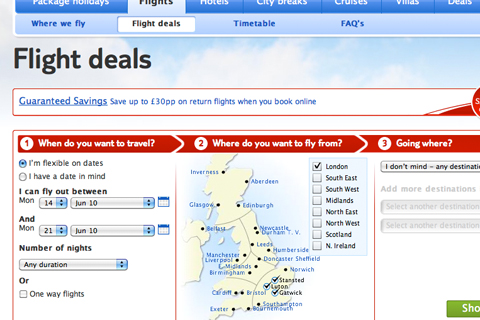
Eine Abflugsoption von London bezieht entsprechend die Flughäfen Gatwick, Luton und Stansted mit ein.
Ebenfalls angepasst ist das Design, Thomson Flights präsentiert sich im Unterscheid zu vorher nun im leichten Outfit. SinnerSchrader hat das Redesign umgesetzt und die neuen Flash-Anwendungen entwickelt. Weitere Optimierungen sind bereits in Planung.
DLD Women: Warum eine Konferenz für Frauen Sinn hat
Welchen Sinn hat eine Konferenz für Frauen wie die DLD Women letzte Woche in München? Werden dort nur die üblichen Frauenthemen verhandelt, als da wären: Warum schaffen es so wenig Frauen in Führungspositionen? Müssen Frauen wie Männer sein, um Erfolg zu haben? Wollen sie das – Erfolg haben oder wie Männer sein? Welche Unterschiede gibt es zwischen Frauen und Männern?
Ja, auch die üblichen Frauenthemen. In einem Punkt nämlich unterscheiden sich Männer und Frauen herzlich wenig: Beide reden am liebsten über sich selbst und über ihre eigenen Themen. Und weil dem so ist, hat auch eine Frauenkonferenz Sinn. Sie gibt Frauen Raum für ihre Themen, die auf klassischen Männerkonferenzen keinen oder nur wenig Platz finden. Und die Männer nerven.
Gibt es Konferenzen für Männer? Vielleicht nicht explizit, aber was ist eine Konferenz, bei der 95 Prozent der Sprecher und 85 Prozent der Teilnehmer Männer sind? Der Normalfall? Bei Burdas DLD Women war es umgekehrt: Männer waren zwar zugelassen, aber auf der Bühne wie im Auditorium klar in der Minderheit. Gefühlt im Verhältnis 30:1.
Viele der anwesenden Frauen waren zum ersten Mal auf einer DLD-Konferenz. Diese Tatsache allein macht die DLD Women zu einer perfekten Line Extension: Sie tut dem Mutterformat nicht weh, erschließt der Marke aber eine neue Zielgruppe. Es ist immer schlau, einen Ableger, sei es nun eine Konferenz oder eine Zeitschrift, um eine Zielgruppe herum zu bauen.
Noch dazu, wenn es eine Zielgruppe ist, die so dermaßen im genetischen Code von Burda liegt wie die Zielgruppe Frauen. Schließlich war es Aenne Burda, die mit „Burda Moden“ die weltgrößte Modezeitschrift etablierte. Frauen- und Modemarken wie „Bunte“, „Elle“, „Instyle“ oder „Freundin“ gehören zum Kerngeschäft von Burda.
DLD steht für Digital, Life, Design. An Life(style) und Design war kein Mangel letzte Woche in München, doch digital sind die Themen nur noch gelegentlich, wenn etwa die Zukunft der Medien aus weiblicher Perspektive debattiert wird oder es um Fashion, Style & Blogs geht. Die Faszination der Marke DLD geht von den Menschen aus und von der glänzenden Inszenierung, nicht so sehr von den Themen.
Facebook and Twitter Users Spend More Online
Need a reason why you should invest in a brand presence on Facebook or Twitter? Have a look at this research recently published by Comscore. According to their findings, heavy users on Facebook and Twitter spend more money online than average users.
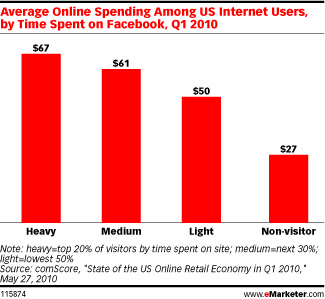
Comscore defines heavy users as the top 20 per cent of visitors by time spent on the site, medium users as the next 30 per cent and light users as the lowest 50 per cent. The average e-commerce spending per visitor increases in correlation with the Facebook usage. Compare the numbers with the average Internet user who spent slightly less than 50 US-Dollars in the first quarter of 2010. Or, as eMarketer puts it:
Notably, Internet users who did not visit Facebook at all bought significantly less online than average, spending only $27 during the quarter. Not only are retailers on Facebook targeting above-average spenders, but the audience missing from the site is also worth much less in revenues.
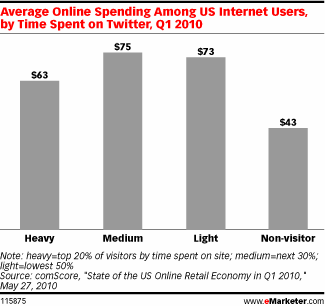
On Twitter, we see a different picture, with even higher average spendings, but without a linear correlation between Twitter usage and spendings. What Facebook and Twitter users have in common is that they spend more money online than non-users.
Please note that these figures apply to the US market. Don’t know if there are similar figures available for Germany or Europe.
Hat tips to eMarketer and s2planning.
Lars Hinrichs is Back on the Block with HackFwd
There hasn’t been much noise about Lars Hinrichs after he resigned as Xing CEO in early 2009 and subsequently sold his shares to Burda. But now he appears back on the European start-up scene with his new venture aptly named HackFwd.
At HackFwd, Lars takes the role of Executive Geek. That reminds me of the old days at Böttcher Hinrichs where Lars also was the Chief Geeking Officer, kind of. Böttcher Hinrichs went bust in 2001, but this experience somehow laid the foundation for what later became Xing. Founded in 2003, Xing went public in 2006, a few days before Lars turned 30.
HackFwd provides pre-seed financing and all kind of support to geek founders with original, consumer-focused ideas. In exchange, HackFwd gets 27 per cent of the company. As of today, HackFwd lists four start-ups on its website, with TheDeadline amongst them (we already mentioned TheDeadline). According to Lars, the mission of his new company is simple:
Free Europe’s best developers from their day jobs to help them build their own game-changing companies.
But even if this sounds much like the incubator idea, the company sees itself as investor rather than incubator. The basic idea is summarised in this neat video:
Besides Lars, three other investors serve on the board: Marco Börries of StarOffice, StarMoney and Yahoo fame, Stefan Richter, the founder of freiheit.com, and Jean-Paul Schmetz, the former CTO and CEO of Burda Digital.
Qype Comes to the Blackberry Soon
The App Economy brought us back to the ancient times before the advent of the Web when you had to develop different versions for several platforms. What has been PC, Mac or Linux in the old days is now iPhone, iPad, Android or Blackberry. Web-based services are forced to enter the world of application development, just to avoid getting lost in the transition from the residential to the mobile Web.
Qype launched its web platform in 2006. While the first iPhone app, dubbed Qype Radar, appeared as early as 2008, Blackberry users still have to wait for their app. But not for long, as we’ve learned from Qype founder Stephan Uhrenbacher. The Blackberry app is about to launch in the next few days, Stephan told us.
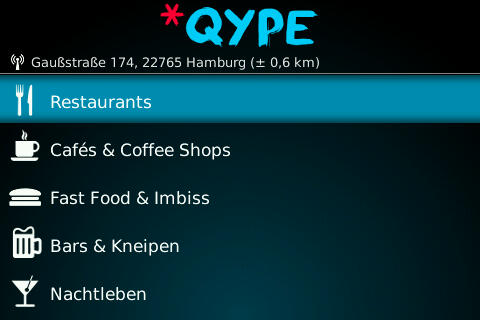
We had the chance to take a look at the current private beta version. The home screen (above) looks pretty straightforward, showing categories like restaurants, cafés or fast food. One click later the user is provided with a list of nearby venues in the selected category.

If you select a venue, the app shows basic data like the address, opening hours and aggregated user reviews.

The real killer app would be the capability to post reviews of venues as you go. According to Stephan, this feature will be added soon after the launch. The current iPhone app already allows you to create new Qype locations directly from your phone, add reviews and upload photos. This seems pretty obvious, but the current user base of Qype might still need some time to adapt to the mobile space. Let’s hope that in the meantime other players like Foursquare don’t eat Qype’s lunch.
For the future, I expect most of the data silos in the location space to open up, sharing their data over the platform boundaries, similar to what’s already happening in the social network’s realm. But that’s another story.
Tinypay.me is an Online Shop in a Nutshell
Tired of Ebay? Looking for a simple and do-it-yourself, social-media-enabled e-commerce solution? Then you should check out Tinypay.me. With Tinypay.me, you can create quick listings for your product or service, put it online and just sell. Nothing more then name, price and description is needed, you can even do without a picture (of course you shouldn’t).
Other options include donating the resulting money to charity, and name a location for your product or service in case that’s relevant. Share your listing on Facebook, Twitter and Google Product Search or integrate a simple shop on your blog or website. That’s all. Payment service is provided by Paypal, without other options.
Tinypay.me is amazing because of its simplicity. The whole setup is so easy and straightforward that it can be done in just one minute or even less. The downside is of course that the service lacks many features you might want to use, for example ratings for products and sellers. But their roadmap look promising, with features like an API on the way.
As Tinypay.me launched last February, the service itself isn’t yet a marketplace like Ebay, Etsy or Amazon with a huge audience of potential buyers. But if you already have your own audience on Facebook, Twitter, your website or blog, Tinypay.me maybe just the tool you need to sell something to the people that follow you.
But, and that’s a huge „but“, as Tinypay.me takes a five per cent commission (and Paypal deducts another chunk of your money), you need to stomach that. In many cases Ebay or Amazon might still be the better choice, taking less money and bringing in huge amounts of potential buyers, even though the selling process is not as easy as with Tinypay.me.
Hat tips to Denkzelle and Mashable.
mirapodo hilft bei der Suche nach dem passenden Schuh
Für Stephanie Caspar, Gründungsgeschäftsführerin von mirapodo, sind zufriedene Stammkunden wichtiger als eine exorbitante Neukundenquote. Joel Kaczmarek, Chefredakteur von Gründerszene, flirtet fragt sie im Interview nach der Strategie, den Alleinstellungsmerkmalen und dem Hintergrund von mirapodo, das via Baur zur Otto-Gruppe gehört.
Neben exzellentem Kundenservice und bestmöglicher Kundenorientierung hilft mirapodo auch dabei, das Problem No. 1 beim Onlineschuhkauf zu entschärfen: die richtige Größe zu finden.
Wir haben sehr viele Informationen zu den Schuhen, zu den Maßen, wie unterschiedliche Marken die Passform gestalten und können aufgrund deiner Kaufhistorie dann auch sagen, welche Größe du nehmen solltest.
Wir bei SinnerSchrader haben bei der Entwicklung des Shops und der Website für mirapodo jede Menge Intelligenz in dieses Thema investiert. Denn wie für jeden Versandhändler ist auch für mirapodo eine niedrige Retourenquote erfolgsentscheidend. Schuhe, die nicht passen, werden zurückgeschickt – entfällt dieser Grund, sinkt die Zahl der Rücksendungen.
In den USA hat Zappos, das 2009 von Amazon übernommen wurde, das Thema Onlineschuhkauf erfolgreich gemacht. In Deutschland tritt mirapodo, das im März offiziell gestartet war, gegen Zalando an, eine Gründung der Samwer-Brüder. Zalando musste sich schon vor dem offiziellen Start von mirapodo einen Plagiatsvorwurf gefallen lassen.
Why I am at a loss with strings.com
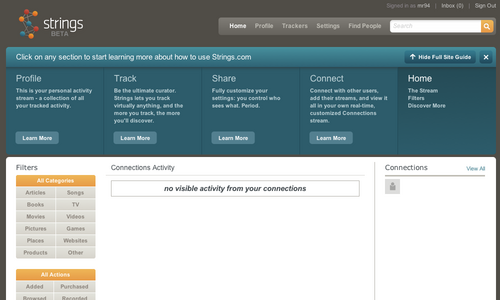
Another promising start-up that recently caught my attention is strings.com or maybe just strings. Their pitch sounds as follows:
Strings is a social tracking and filtering platform that allows you to share and uncover experiences that are relevant to you. Strings incorporates strong privacy controls, easy filtering, and tracking support that allows your actions on and offline to automatically identify personalized trends worth following.
First of all, the name is way too generic, news and coverage about strings are hard to find. They launched in February and managed to get on stage at Web 2.0 Expo, but that’s all I know. Who is the founder? The site gives me no idea. They don’t have a pressroom either.
The sign-up process is old-school – you have to create just another account, no Open ID, Google, Facebook, Twitter or whatsoever. This is lame, but there might be a reason for this. After the sign-up, strings allows you to create „trackers“ for the usual suspects like YouTube, flickr, Foursquare, Twitter, last.fm, but also for purchases at Apple, eBay and the like. For some trackers, you have to provide your login data, which is lame too, but again there might a reason for this.
Why I am completely at a loss with strings is the social part – that’s missing. I’ve no idea how many people use strings, but it’s clear that I can’t find my peeps. There is no way to import my friends from other services like Twitter or Facebook. Without friends, the whole thing is pointless.
And the design isn’t very pretty anyway.
[Hat tip to Denkzelle]
First Steps with TheDeadline Somewhat Mixed
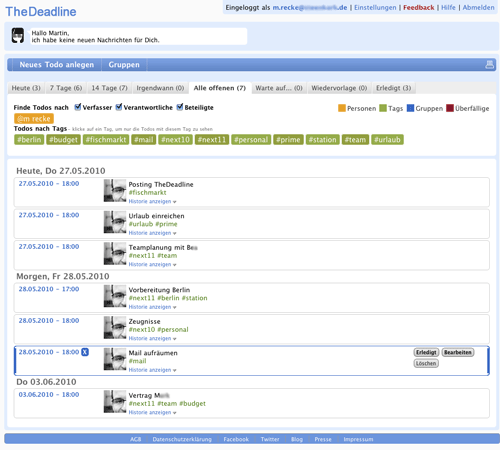
Last week at Google I/O, a tiny but interesting start-up from Hamburg debuted. It’s called TheDeadline and has something to do with task management and project management. I took some time today to try it out, and my first impressions are somewhat mixed.
First of all, I wasn’t able to login with one of my Google Apps accounts. This may be my fault, but TheDeadline isn’t very verbose on this. Second, I didn’t see the promised integration with Google Contacts and Google Calendar. This may be related to the first problem.
Third, the interface looks geeky and somewhat clumsy. This may stem from TheDeadline’s origin at Hamburg-based IT service provider freiheit.com and also be the handwriting of Lars Hinrichs who recently invested in TheDeadline. But this may change over time, as Lars has already proven with Xing that he founded in 2003. Xing went public in 2006 and was later sold to Burda.
I’ve quickly hacked in some to-dos and particulary liked the tagging functionality. Didn’t see anything of the touted artificial intelligence yet, but that remains to be seem. TheDeadline definitely made it to my watchlist.
